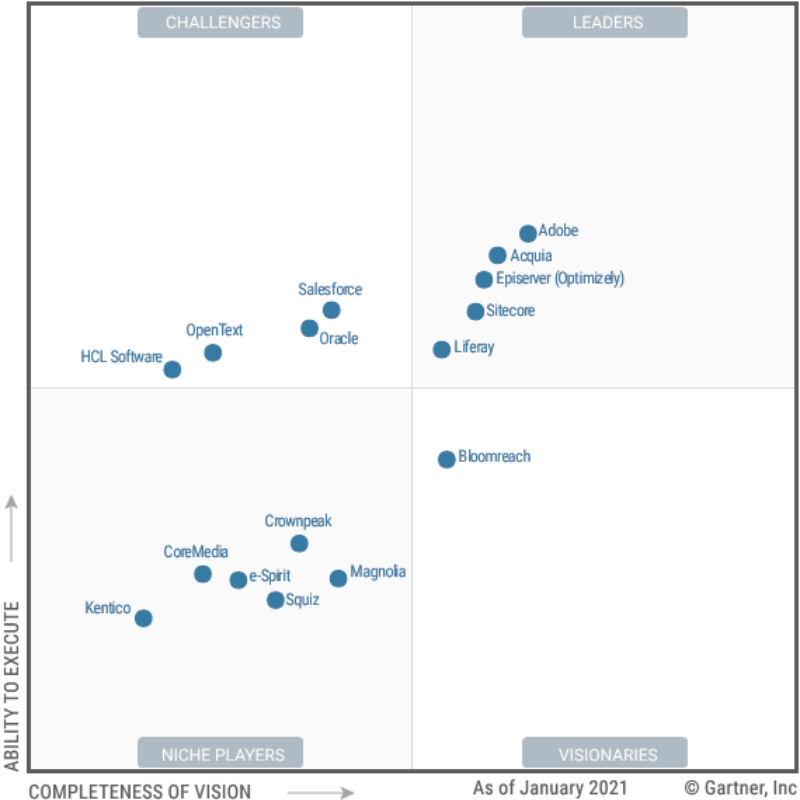What is the significance of the Digital Experience Platform?
What can we imagine under the term Digital Experience Platform or DXP? Where did they come from, and what are their benefits? Do you know who performed best in the Gartner Magic Quadrant 2021 for the Digital Experience Platform?

So what does DXP mean?
Gartner defines the digital experience platform (DXP) as “an integrated set of technologies based on a common platform that provides a wide range of users with consistent, secure, and customized access to information and applications across many digital contact points.”
Companies use digital experience platforms to create, deploy, and continually improve websites, e-shops, mobile applications, and other digital environments. DXP combines and coordinates applications, including content management, search, personalization, integration, collaboration, analytics, testing, mobile and omnichannel support. Digital experience platforms help build and manage customer contact points across multiple channels and provide development tools and pre-built templates. That allows companies to create functional applications with low development needs. They offer companies an integrated set of tools to strengthen customer relationships.
Development from CMS through WEM to DXP
We can say that DXPs evolved from CMS, which is used to create and manage web content. But having just an e-shop or website is no longer enough. Digital marketing has grown to include social networking, A / B testing campaigns, the omnichannel approach, or content personalization. Managing all this from different software tools is not efficient, and trying to connect them can be detrimental rather than beneficial.
The first content management systems appeared in the late 1980s. These monolithic CMS allowed static content. In the late 1990s, companies began offering dynamic content. User-generated content has been added, and the rise of mobile devices has been added, which has logically led to a web experience management (WEM) solution. With WEM, organizations began collecting engagement data, creating personas, and using both to provide a personalized experience. However, the problem with WEM systems was that they were designed exclusively for marketing and were difficult to connect to the rest of the organization and integrate with ERP or CRM. The operation was neither efficient nor smooth, which meant the loss of many potential customers. As the importance of digital CX grew, so did the need for deeper integrations, which led to the rise of headless architecture and the creation of digital experience platforms.
What are the benefits and advantages of DXP?
For 80% of all companies globally, the main priority is to improve the customer experience. Compared to other companies, those in this area show higher year-on-year growth in practically every customer life cycle metric, such as brand awareness (1.6 times higher on average), average order value (1.9 times higher on average), or ROI ( on average about 100% higher).
The digital era requires not only the delivery of content to websites, e-mail, mobile applications, customer portals, social media, IoT devices, VR / AR devices, kiosks in stores, POS systems, and more, but also the connection of information and experience on them. Today, there are 6.5 devices connected to the network (Statista) per person worldwide, and 73% of customers use multiple channels during their shopping journey. So it’s simply not enough to deliver content to each channel individually – it has to combine into a consistent, connected, and continuous CX that leads the user to a specific result.
All-in-one solution
DXP controls CX from one place. The preparation of all content for all digital communication channels is in one tool. You deliver from one place, collect customer data from them and evaluate success. And you also save costs and time.
Omnichannel
DXP allows omnichannel access. In short, from a digital experience platform you can prepare all content for the web, e-shop, social networks, mailing, etc., and at the same time maintain uniformity.
Data centralization
Centralized data is the basis of DXP. It can connect them, and thanks to that you have information about the behavior of your customers. You can offer them personalized and relevant content and optimize everything on an ongoing basis.
Personalization
DXP can prepare a detailed customer profile. That allows you to tailor personalized content relevant to each customer and increases the chances of buying and returning to you.
API plays an important role
All-in-one solutions can be distrustful because their features may not be as perfect as stand-alone specialized “point” tools. However, thanks to the API, your favorite tools can be integrated into a single platform.
Automation and AI
Artificial intelligence and machine learning play an important role in data processing and evaluation as well as personalization. AI can recognize customers based on their behavior and offer customized content. It can assess the success of campaigns, optimize them, and much more.
Adobe received another award
Gartner reassesses Adobe as a Leader in Digital Experience Platforms in its annual Magic Quadrant report. Winning this award confirms the high quality of the Adobe Experience Cloud environment and its success.
Adobe Experience Cloud helps businesses combine content, analytics, and automation with machine learning to deliver an engaging, personalized customer experience. It is built on an open, scalable platform where all products work together and are integrated with Magento. Thanks to the connection with Magento, it offers a solution for managing the business environment.
Gartner Magic Quadrant for Digital Experience Platforms 2021

With DXP, you can gain more loyal customers by offering a personalized and powerful customer experience. Of course, we can expect digital experience platforms to continue to grow and expand with new features as new technologies, communication channels, and AI development. At least with Adobe Experience Cloud, you can be sure of that!

